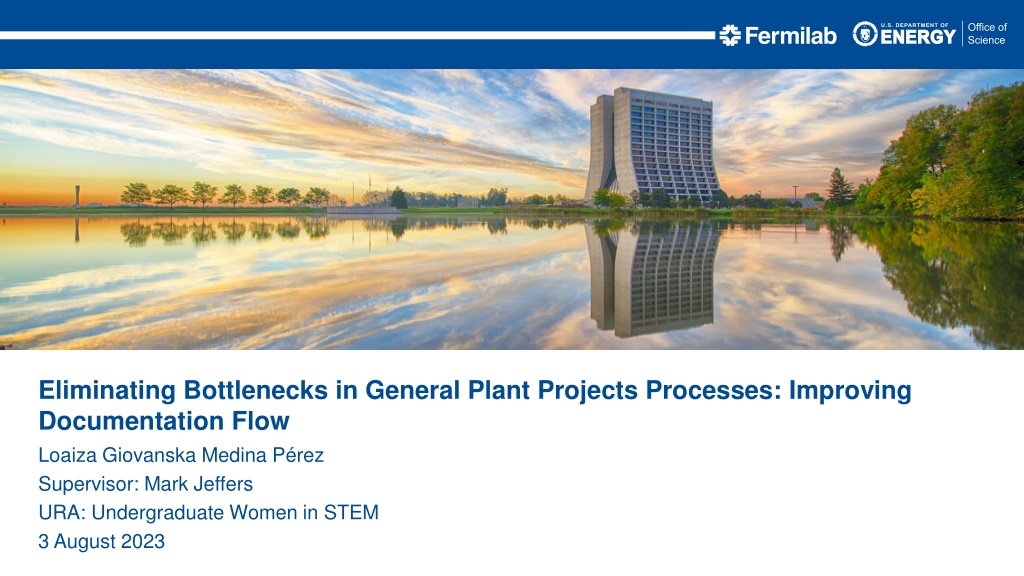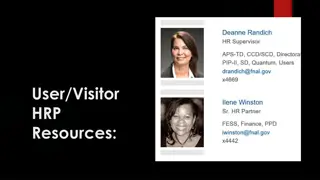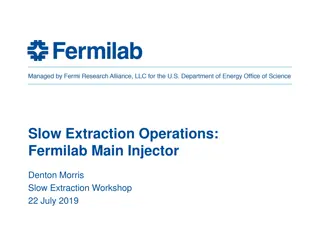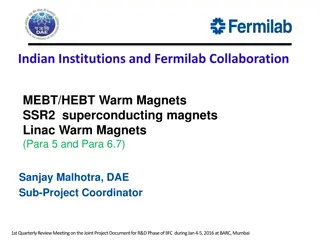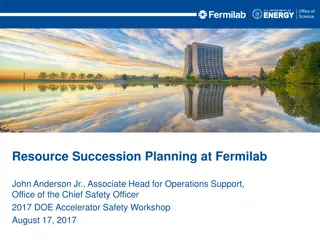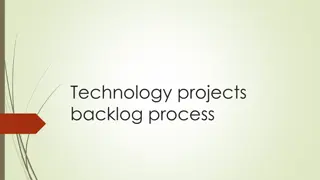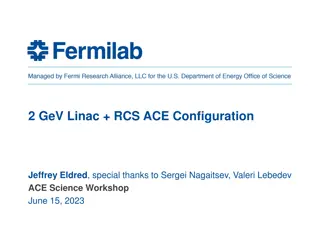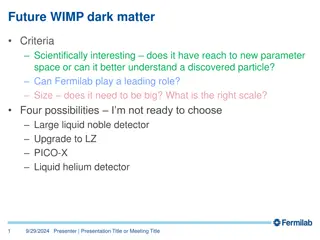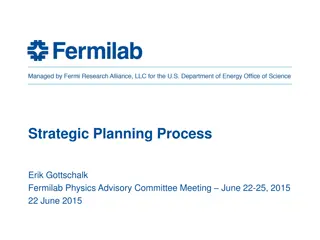Enhancing Project Management for General Plant Projects at Fermilab
Improving documentation flow and eliminating bottlenecks in general plant projects at Fermilab can lead to successful project execution, enhancing credibility, reputation, and access to future funding. The Infrastructure Service Division (ISD) plays a crucial role in efficiently managing real and personal property assets. Understanding the construction process overview for new asset projects is vital, especially for General Plant Projects (GPP).
Download Presentation

Please find below an Image/Link to download the presentation.
The content on the website is provided AS IS for your information and personal use only. It may not be sold, licensed, or shared on other websites without obtaining consent from the author. Download presentation by click this link. If you encounter any issues during the download, it is possible that the publisher has removed the file from their server.
E N D
Presentation Transcript
Eliminating Bottlenecks in General Plant Projects Processes: Improving Documentation Flow Loaiza Giovanska Medina P rez Supervisor: Mark Jeffers URA: Undergraduate Women in STEM 3 August 2023
The Benefits of Successful Projects for Fermilab A project that is successfully carried out without delays and has multiple benefits for an organization like Fermilab: Credibility and reputation: A well-executed project reflects effective management by Fermilab. This enhances its credibility and reputation within the U.S. Congress and the HEP community. Access to future funding: The success of a project and the demonstration of good management can open doors for future Congressional funding requests. When resources are sought for improvements and advancements, having a track record of meeting milestones and deliverables significantly improves the chances for continuing Congressional funding support. Cost accuracy: Meeting the project's schedule and scope helps keep costs under control. Being off by factors of two to three has large consequences. Delays and changes in scope often lead to increased expenses, which can negatively impact the project s value and viability. 2 Loaiza Medina | URA Final Presentation
Infrastructure Service Division (ISD) ISD Overview Purpose Efficiently manage real and personal property assets for Fermilab operations. Real Property Planning, designing, constructing, renovating, and disposing of real property. Operating, maintaining, repairing, and surveilling real property assets. Overseeing real property data development, maintenance, and reporting, including data validation coordination. Providing dedicated staff for Fermilab's real property data as the main point of contact internally and externally. Personal Property Managing Fermilab personal property from acquisition to disposition. Ensuring efficient utilization and inventory control. Handling loan documentation, reuse, and disposal processes. Focus of this project is on the processes around the planning, design , and construction of real property 3 Loaiza Medina | URA Final Presentation
Construction Process Overview The general process for construction of a new asset follows the general format of planning the project, designing the asset, physical construction activities, and then turning over the new asset to operations. Specific requirements of the process are determined by the cost and complexity of the project. In general, the process falls into four major categories: Capital Minor Construction Projects (e.g., General Plant Projects) Non-capital Improvement Projects 413 Projects Tailored 413 Projects Costs > $50M Established processes identified from DOE O 413 Costs between $25M and $50M Tailored processes identified from DOE O 413 Costs between $500k and $25M Further tailored processes identified from DOE O 413 Costs < $500k The most simplified processes tailored from DOE O 413 Focus of this Project: GPP Processes 4 Loaiza Medina | URA Final Presentation
General Plant Projects GPP Overview Managed by the Head of the Engineering Department within the Infrastructure Services Division (ISD). These projects provide for design, construction, additions and/or improvements to land, buildings, and utility systems. Essential to adapt facilities to new or improved production techniques, achieve operational efficiencies, and address health, fire, and security concerns. Goal is to execute the entire project from design through construction within two-three years. The focus of this study is to identify any bottlenecks within the processes for executing GPPs at Fermilab, specifically focusing on internal processes to initiate the projects. Methodology used was to review current procedures, interview staff members involved in the processes (e.g., project team members, program manager, procurement and financial staff), map out the process, and identify potential bottlenecks. 5 Loaiza Medina | URA Final Presentation
GPP Examples GPP Accelerator Campus Utility Corridor GPP Accelerator Campus Master Substation Feeder 6 Loaiza Medina | URA Final Presentation
Bottleneck It is a restriction or congestion point in a process. It represents a stage or resource that limits the production capacity of the system. It causes delays and accumulation of work in the workflow. It is a factor that negatively affects the efficiency of the process. It can be caused by various factors, such as lack of resources, inefficient communication, or unclear procedures. 7 Loaiza Medina | URA Final Presentation
Methodology: Lead Time It measures the time from the scheduling to the completion of a task, revealing efficiency and productivity. It enables organizations to improve planning and decision-making for faster and more effective execution of activities. Companies can identify areas of improvement in their processes and optimize resource allocation based on lead time analysis. 8 Loaiza Medina | URA Final Presentation
Methodology: Lead Time Analysis 9 Loaiza Medina | URA Final Presentation
Visualizing GPP Processes Through a Flowchart 10 Loaiza Medina | URA Final Presentation
Methodology: Lead Time Division Finance Finance Finance Finance Finance Finance Project Admin Project Admin Finance Project Admin Finance Other Other Other Other Other Other Other Other Other Other Procurement Procurement Procurement Procurement Procurement Procurement Procurement Finance Finance Finance Finance Finance Finance Finance Finance Finance Activity No. 1 2 3 4 5 6 7 8 9 10 11 12 13 14 15 16 17 18 19 20 21 23 24 25 26 27 28 29 30 31 32 33 34 35 36 37 38 Activity Time (days/activity) 1 2 1 2 0.5 1 1 90 1 45 1 0.1 0.1 0.1 0.1 0.1 0.1 0.1 1 1 3 120 180 1 5 6 2 0.25 10 1 1 End of the month 1 0.5 0.5 45 1 525 60% 26% 13% Data Project creation and assign number Approval of Project Key Members Form by: Division/Section Head, Budget Officer and Chief Financial Officer Creation of budget task requests by Financial Manager (Senior Financial Manager) Approval and creation of budget task requests in Project Account System by Budget Office Senior Financial Manager upload Budget Task Requests Submit the Project Request Form and approved Project Plan to obtain access to the funds PM makes changes Change Control Board approves the changes in ETR system Submit Project Request Form Mod to Senior Financial Manager Approval of the PRF by: Division/Section, CFO/Budget, Chief of Championing Organization and Chief Operating Officer Send the approved PRF to Budget Officer Create Purchase Requisition by Project Manager Create and sends Purchase Requisition by Project Manager to Admin Admin submit PR in Oracle EBS and sends it to Gate Keeper Gate Keeper sends PR to Engineering Department Head Engineering Department Head approves PR and returns it to Gate Keeper Gate Keeper sends PR to Division Head for signing Division Head signs PR and returns it to Gate Keeper Gate Keeper forwards PR to Property Accounting for review Property Accounting sends it to the Director's Gate Keeper Approval by Chief Operating Officer or Approval by Director Request for Proposal or out for bid if required Creation Purchase Order Notice to Proceed If needed Change Orders Project Complete Create Engineering Task Requests by Customer or Project Manager Requests enter ETR into Kronos Paid Invoices by Accounting Close Purchase Orders by Senior Financial Manager Close Budget Tasks by Senior Financial Manager Obtain all indirect rates at the end of the month Notify Project Accounting that the project can be closed Run TSR and ensure that everything is at zero Develop Notice of Project Closing Sign the Notice of Project Closing by: Division/Section, Budget Office, Accounting, Procurement and Directorate Send the Notice of Project Closing to Property Accounting Total Lead Time Procurement Project Admin Finance 11 Loaiza Medina | URA Final Presentation
Results The Procurement area accounts for 60% of the total time spent in the GPP document flow, despite handling only 18% of the total documentation. The Finance area manages 53% of the total tasks and documents in the process but occupies only 13% of the total time in the documentation process. Conducting a thorough analysis is crucial to understand the complexity of Procurement tasks and improve its processes, as they are the main contributors to GPP delays. 12 Loaiza Medina | URA Final Presentation
Conclusion and Future Work Conclusion Procurement area consumes 60% of the total time in documentation, approvals, and tasks in GPP projects, while Project Administrator manages 26%, and Finance handles 13%. Future Work Comprehensive investigation needed to identify factors impacting Procurement and Project Administrator divisions to provide recommendations for improving lead time. Evaluation of human and technological resources to ensure efficient allocation. Identification of internal and external obstacles affecting lead time. Surveys, team feedback, and benchmarking to gather relevant insights. Development of concrete recommendations and an action plan to improve efficiency in the Procurement and Project Administrator divisions. 13 Loaiza Medina | URA Final Presentation
Future Recommendations Establish clear and efficient workflows for document review and approval, ensuring that tasks are assigned to the appropriate individuals and reasonable deadlines are set. Provide training to the staff involved in the documentation flow, ensuring they are familiar with the procedures and tools used, which will enhance their efficiency and accuracy. Promote a culture of open and collaborative communication throughout the organization, enabling quick resolution of any issues or questions related to documentation and avoiding unnecessary delays. Conduct regular reviews of the documentation process to identify areas for improvement and adjust procedures as needed to optimize efficiency. 14 Loaiza Medina | URA Final Presentation
